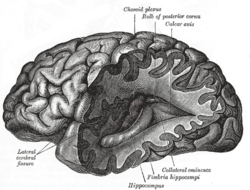Slice preparation
The slice preparation or brain slice is a laboratory technique in electrophysiology that allows the study of a synapse or neural circuit in isolation from the rest of the brain, in controlled physiological conditions. It involves stimulating and/or recording from a slice of brain tissue immersed in artificial cerebrospinal fluid. The technique allows for greater experimental control, through elimination of the effects of the rest of the brain on the circuit of interest, careful control of the physiological conditions through perfusion of substrates through the incubation fluid, to precise manipulation of neurotransmitter activity through perfusion of agonists and antagonists. However, the increase in control comes with a decrease in the ease with which the results can be applied to the whole neural system.
Benefits and limitations
When investigating mammalian CNS activity, slice preparation has several advantages and disadvantages when compared to in vivo study. Slice preparation is both faster and cheaper than in vivo preparation, and does not require anaesthesia beyond the initial sacrifice. The removal of the brain tissue from the body removes the mechanical effects of heartbeat and respiration, which allows for extended intracellular recording. The physiological conditions of the sample, such as oxygen and carbon dioxide levels, or pH of the extracellular fluid can be carefully adjusted and maintained. Slice work under a microscope also allows for careful placement of the recording electrode, which would not be possible in the closed in vivo system. Removing the brain tissue means that there is no blood–brain barrier, which allows drugs, neurotransmitters or their modulators, or ions to be perfused throughout the neural tissue. Finally, whilst the circuit isolated in a brain slice represents a simplified model of the circuit in situ, it maintains structural connections that are lost in cell cultures, or homogenised tissue.
However, slice preparation also has some drawbacks. Most obviously, an isolated slice lacks the usual input and output connections present in the whole brain. Further, the slicing process may itself compromise the tissue. Slicing of the brain can damage the top and bottom of the section, but beyond that, the process of decapitation and extraction of the brain before the slice is placed in solution may have effects on the tissue which are not yet understood. During recording, the tissue also "ages", degrading at a faster rate than in the intact animal. Finally, the artificial composition of the bathing solution means that the presence and relative concentrations of the necessary compounds may not be present.
References
Schurr, Avital, Brain Slice Preparation in Electrophysiology, Kopf Carrier, Vol 15
